Pad Mee Korat
This post contains affiliate links.
Pad Mee Korat is a spicy rice noodles stir-fry that’s quick and easy to make and incredibly delicious. Ground pork, garlic, chilies, egg, bean sprouts, and spring onion get tossed with rice noodles in a flavor-packed sauce that packs a punch!
I have been raving about to anyone and everyone, making, and enjoying this Pad Mee Korat on repeat this month. I’m so excited to share it with you all today because it’s slurp-ili-ciously GOOD and SO YUM!! 😋
What is Pad Mee Korat?
Pad Mee Korat is a spicy rice noodles stir-fry from Korat in northeast Thailand. It’s similar to Pad Thai, but not as famous. I consider it to be a somewhat simplified version of Pad Thai because it requires fewer ingredients. But trust me when I say it does not compromise on flavor at all. In fact, it’s so darn flavor-packed and tasty that I’ve found myself making it more often than my Spicy Pork Pad Thai!
The main difference between Pad Mee Korat and Pad Thai is that it doesn’t call for tofu, Chinese chives, preserved radish, or peanuts. Also, Pad Thai is not usually spicy (although my version obviously is 😉 ), but Pad Mee Korat has a bit of a kick to it.
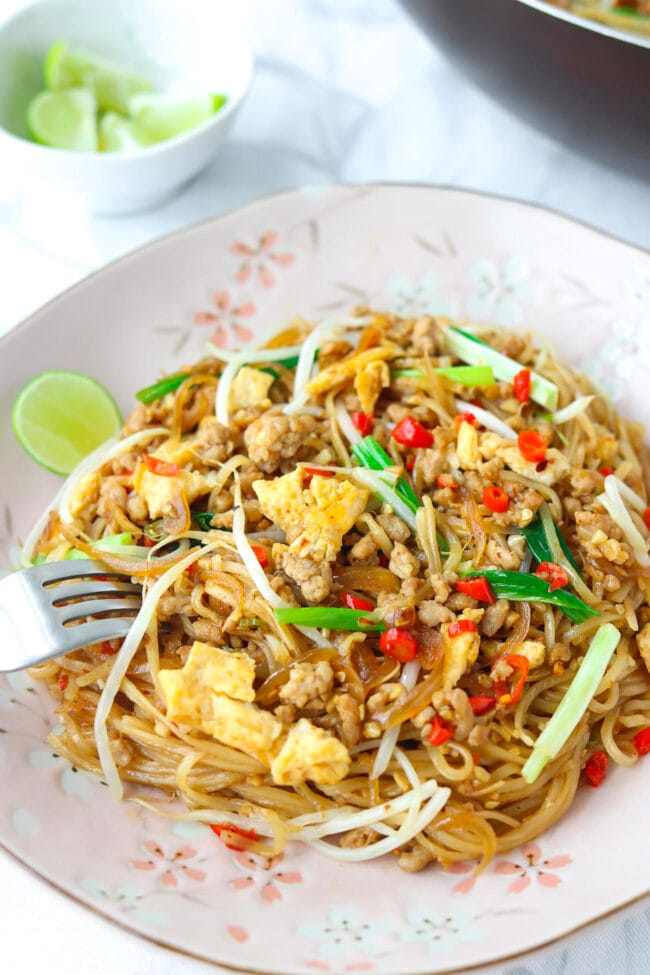
Why This Recipe Works
- It’s quick and easy to whip up in just 30 minutes.
- The sweet, tangy, and spicy sauce is a FLAVOR BOMB, and makes the rice noodles lip-smacking tasty!
- You can customize it with your favorite protein (ground pork, chicken, turkey, beef, or tofu, etc.).
- It’s so darn delcious and addictive to slurp on!
If you love Pad Thai, you need to try Pad Mee Korat. I guarantee that you’ll be coming back for more again, and again, and AGAIN!
Ingredients
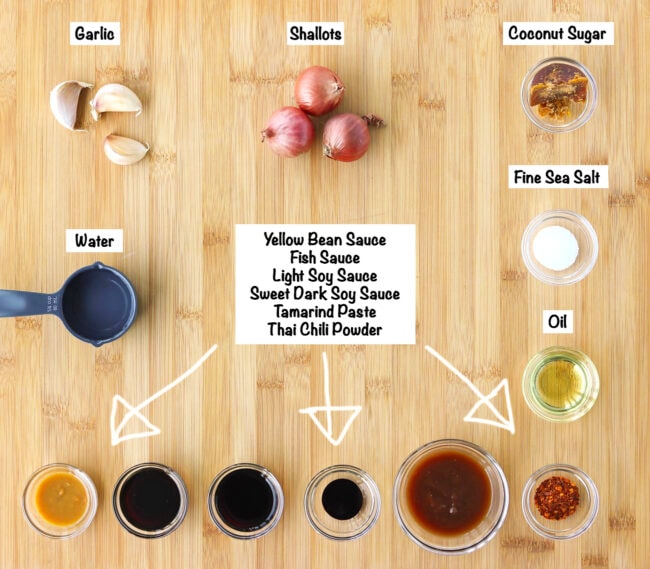
- Yellow Bean Sauce: This is known as ‘tao jiew’ in Thai, and it’s a yellow Asian fermented soybean sauce/paste. There are Chinese and Korean versions available too. It’s a salty sauce with a savory umami flavor. You can find it at your Asian or Thai specialty grocery store, or order it online.
- Tamarind Paste/concentrate): I use a paste that comes in a jar for convenience, and it’s comprised of 70% tamarind and 30% water. You may need to adjust the amount indicated if yours is on the tangier side. I use Talad Thai brand. Make sure to use a Thai tamarind paste and not an Indian one, which is black and sticky.
- Thai Chili Powder: This has a combination of chili powder, flakes, and seeds in it. If unavailable, use crushed red pepper chili flakes.
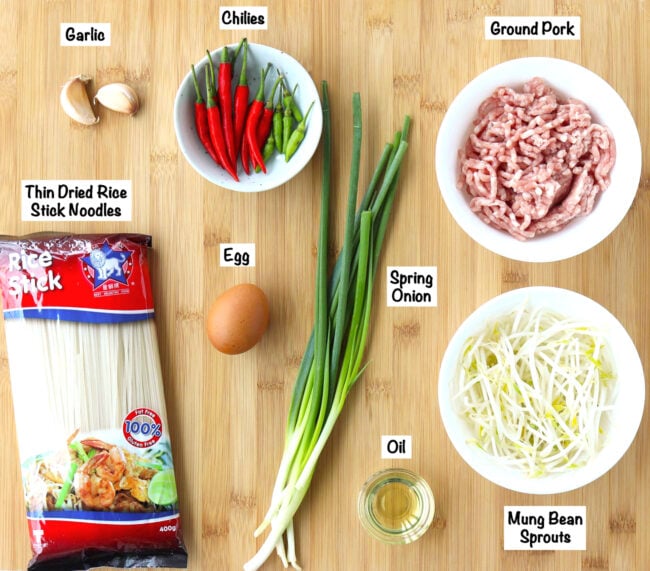
- Ground Pork: I used ground pork here, but thinly sliced skinless pork belly works well too. You’re welcome to use ground chicken, beef, turkey, or tofu cubes instead if pork is not your thing.
- Chilies: I use plenty of Bird’s Eye red chilies and a few Thai ‘prik kee nu’ small green chilies. But you can use any other small hot chilies in your area. Prik kee nu chilies are fiery HOT, and optional for this dish. Feel free to adjust the number of chilies you use (or omit them) based on your heat level preference.
- Thin Dried Rice Stick Noodles: While you can use Pad Thai noodles, which are usually 2-3mm wide, I like to use thin 1mm wide dried rice stick noodles for this dish.
- Asian Red Shallots: Substitute with ¼ of a medium red onion if unavailable.
Full ingredient list and amounts are in the recipe card below.
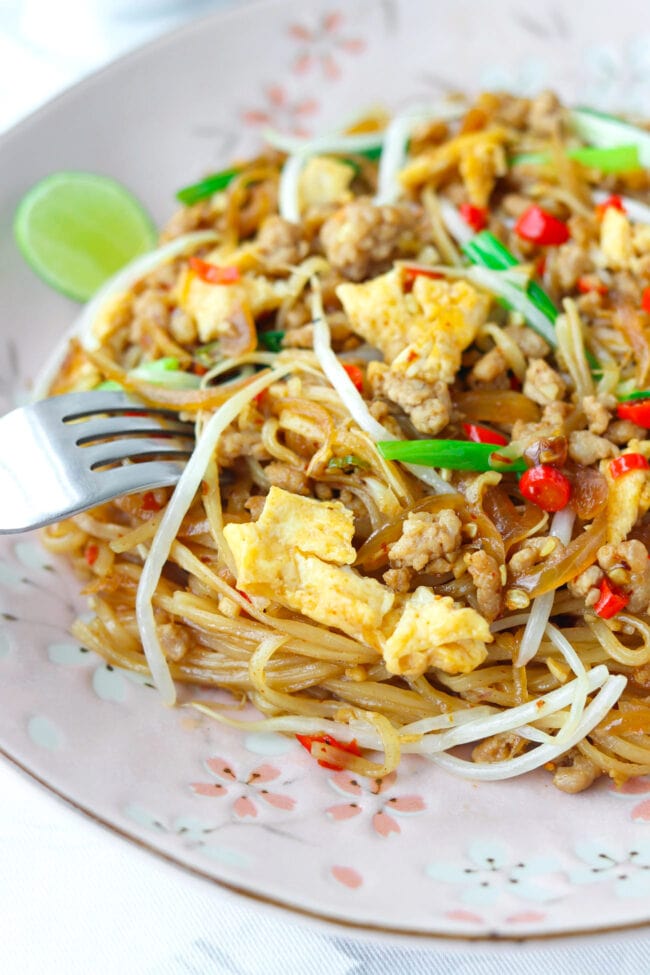
How to Make Pad Mee Korat
Prep:
- Soak the noodles: Soak the rice noodles in bowl filled with hot water for 5 minutes until softened. Then drain and set aside.
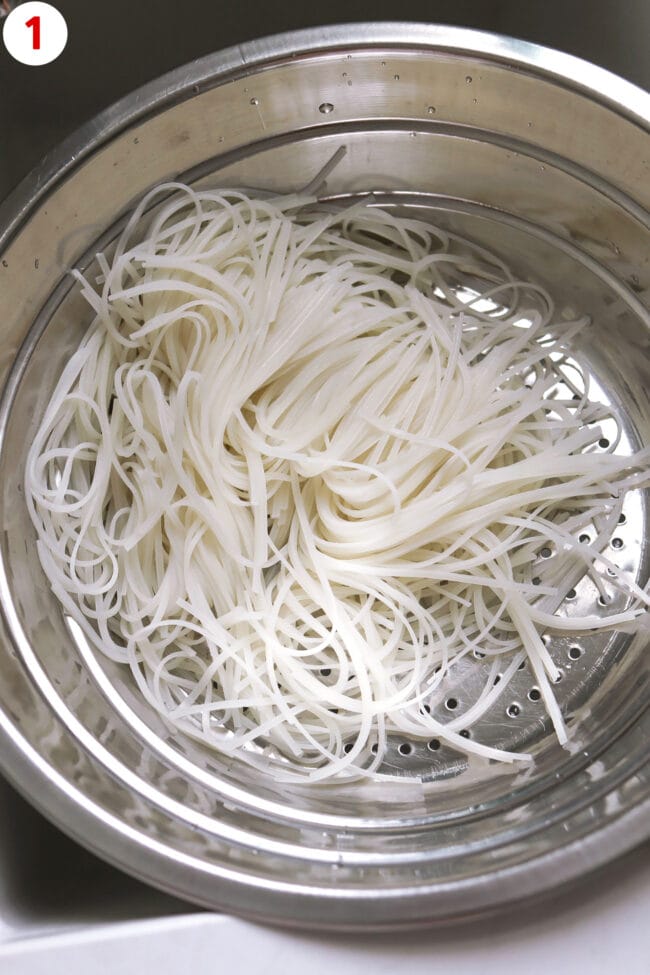
For the Sauce:
- Make the sauce: Heat the canola oil in a small saucepan over medium-high heat. Once hot, add the shallots and garlic and sauté until fragrant. Then stir in the coconut and white sugars until dissolved. Then add the Thai yellow bean sauce, fish sauce, light soy sauce, tamarind paste, and sweet dark soy sauce. Stir, then simmer for half a minute. Add the Thai chili powder and water. Allow to simmer for a couple of seconds, then switch off the heat. Transfer the sauce to a heatproof measuring cup or bowl.
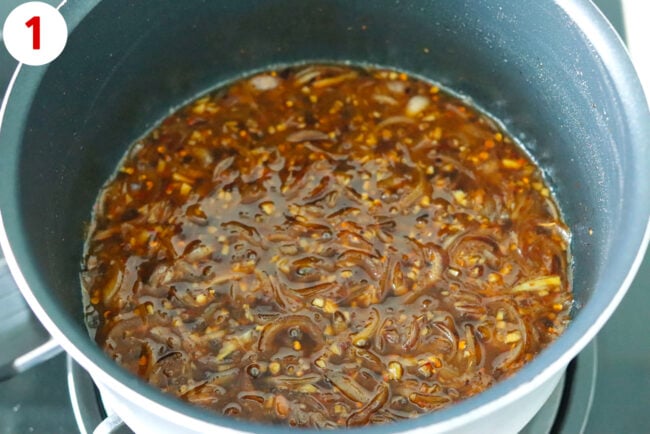
For the Pad Mee Korat:
- Cook the pork: In a bit of oil over medium-high heat in a large wok (or a large deep sauté pan) for 1-2 minutes, or until just cooked through.
- Stir-fry aromatics: Add the garlic and chilies and stir-fry briefly until fragrant.
- Add the rice noodles and sauce: Toss until almost all of the sauce has been absorbed.
- Scramble the egg: Push everything to the side of the wok and add a bit of oil. Pour in the egg and allow to set for a few seconds. Then scramble and toss to combine with everything else.
- Add the mung bean sprouts and spring onion: Toss briefly to combine, then switch off the heat.
- Serve! Divide the Pad Mee Korat evenly onto plates and serve with lime wedges for squeezing.
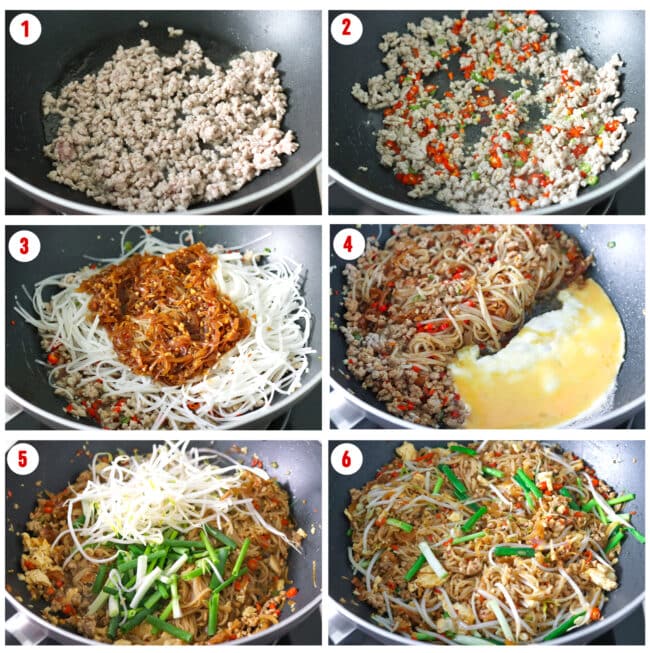
Full detailed instructions are in the recipe card below.
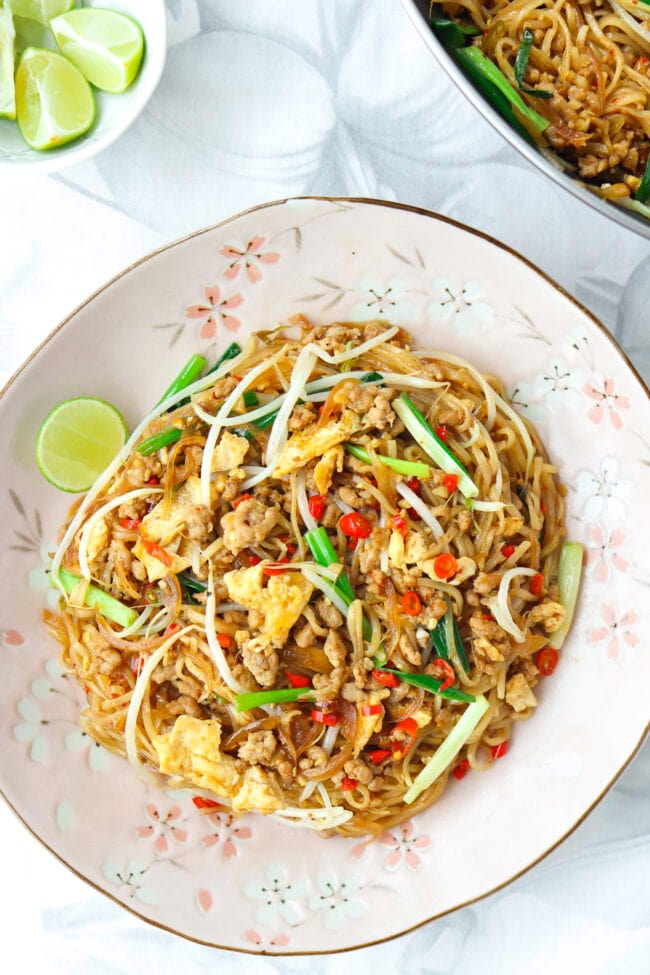
Cook’s Tips
- Soak the noodles when you are about to make the sauce. If you soak them too soon, they will clump together and stick to each other. The sauce will take about the same amount of time to make that the noodles need to soak for (5 minutes). Once the sauce is ready, drain the noodles and proceed with the stir-fry. You can gently toss them with a bit of oil after draining to prevent sticking too.
- Toss noodles using both tongs and a spatula when stir-frying. Use the tongs to lift the noodles up and drop them, and the spatula to fold in the other ingredients to combine. This way, the noodles will get coated with the sauce without clumping together since you’re stretching each noodle strand out.
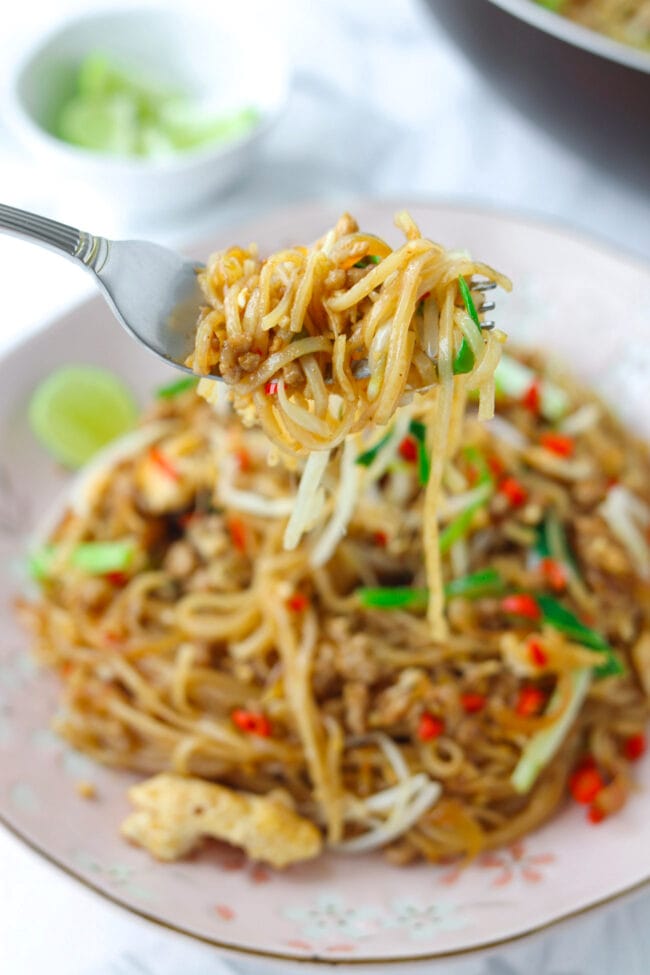
FAQs
Ground chicken, turkey, beef, or shrimp will all taste great. I’ve also made this with thinly sliced skinless pork belly rashers. Depending on how fatty your pork belly is, you may need to scoop out and discard some of the rendered fat so that there is not too much oil in the wok.
Pad Mee Korat is meant to be a spicy noodle dish. However, you can reduce the amount of (or omit) the fresh chilies and chili powder if you prefer a milder dish.
Use a gluten-free soy sauce, gluten-free fish sauce, gluten-free oyster sauce, and gluten-free sweet dark soy sauce like this GF kecap manis. Also, use white miso paste instead of the yellow bean sauce. It won’t be the same flavor, but will still taste good.
Use crispy pan-fried tofu cubes, diced pressed firm yellow tofu, Omnipork®, Beyond Beef®, or other ground plant-based meat substitute instead of the pork. Also, use soy sauce instead of fish sauce (or a vegan fish sauce). If making this vegan, omit the egg as well.
I do not recommend making this ahead as the noodles will absorb the sauce as it sits. Pad Mee Korat tastes best when eaten immediately after cooking, or at least within 2 hours of cooking. You’ll need to heat it up in the microwave for a 1-2 minutes if not serving immediately.
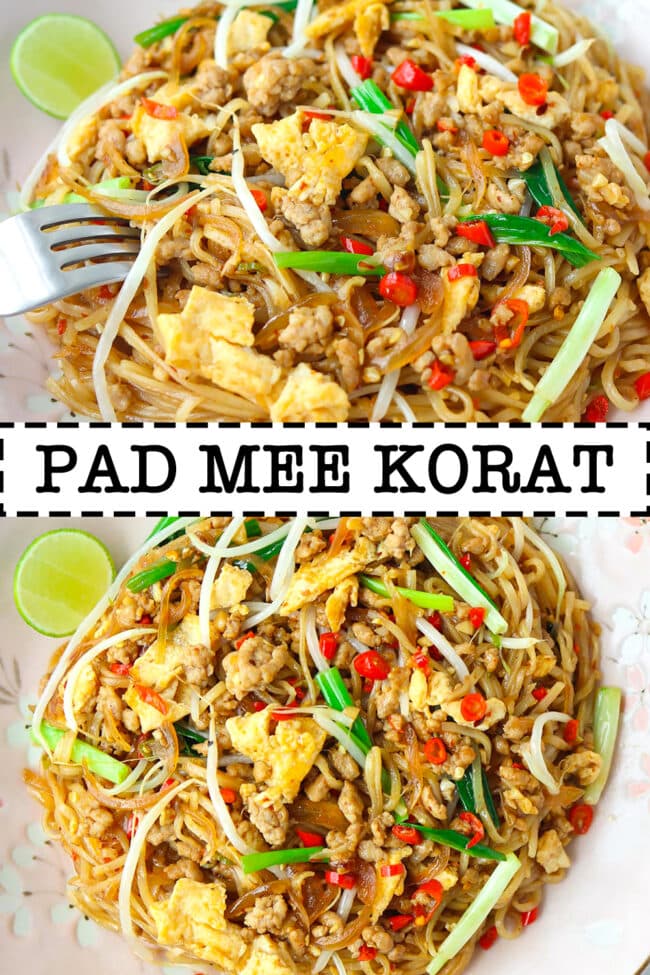
More Asian Noodles
- Spicy Pork Pad Thai
- Pad Kee Mao Gai (Thai Drunken Noodles with Chicken)
- Creamy Spicy Korean Udon Noodles with Bulgogi Chicken
- Stir-fried E-fu Noodles with Shrimp
- Khao Soi Gai (Northern Thai Coconut Curry Noodles Soup with Chicken)
- Or feel free to browse the entire Thai or Noodles recipe collections.
MADE THIS RECIPE? If you make this recipe, leave a comment below and let me know how you liked it! Take a photo and tag it with @thatspicychick on Instagram and hashtag it #thatspicychick and I’ll be sure to share your masterpiece!
STAY CONNECTED! You can also follow me on Pinterest, Facebook or Instagram. Sign up for my email list to get my latest recipe in your inbox weekly!
PrintPad Mee Korat
Pad Mee Korat is a spicy rice noodles stir-fry that’s quick and easy to make and incredibly tasty! Ground pork and rice noodles get tossed with aromatics, egg, and veggies in a wicked delicious flavor-packed sauce!
- Prep Time: 15
- Cook Time: 15
- Total Time: 30 minutes
- Yield: 2 1x
- Category: Dinner
- Method: Stir-fry
- Cuisine: Thai
Ingredients
For the Sauce:
- 1.5 TBLS Canola Oil (or any other neutral flavored oil)
- 3 Asian Red Shallots – thinly sliced (use ¼ of a medium red onion if unavailable)
- 3 Garlic cloves – minced
- ½ disc (about 25 grams) Coconut Sugar – (substitute with 1–2 TBLS crystalized coconut or brown sugar if you have that on hand instead) – shaved with a knife
- 1 TSP White Sugar
- 2 TSP Yellow Bean Sauce
- 1.5 TBLS Fish Sauce
- 1 TBLS Light Soy Sauce
- 2 TBLS Tamarind Paste
- ½ TSP Sweet Dark Soy Sauce
- 1 TSP Thai Chili Powder, to taste (substitute with crushed red pepper chili flakes if unavailable)
- ¼ cup Water
For the Pad Mee Korat:
- 150 grams (5.3 ounces) Thin Dried Rice Stick Noodles (preferably 1mm wide)
- 2 TBLS Canola Oil (or any neutral flavored oil with a high smoke point)
- 200 grams (7 ounces) Ground Pork
- 2 Garlic cloves – minced
- 4–10 Red Chilies (Bird’s Eye preferred, but Holland or other small hot red chilies will work), to taste – chopped
- 1–5 Prik Kee Nu Green Chilies (optional), to taste – chopped
- 1 Egg – lightly beaten
- 1 cup Mung Bean Sprouts – rinsed and drained
- 3 Spring Onions – cut into 1-inch pieces
- To Serve: Lime wedges for squeezing
Instructions
Prep:
- Prepare fresh ingredients: Mince the garlic, finely slice the shallots, and chop the chilies and spring onion. Rinse and drain the mung bean sprouts. Lightly beat the egg in a small bowl. Use a knife to shave the coconut sugar. Set everything aside.
- Soak the noodles: Soak the rice noodles in bowl filled with hot water for 5 minutes until softened. Drain and set aside.
For the Sauce:
- Make the sauce: Heat the canola oil in a small saucepan over medium-high heat. Once hot, add the shallots and garlic and sauté until fragrant. Add the coconut sugar and white sugar, and stir until dissolved. Stir in the Thai yellow bean sauce, fish sauce, light soy sauce, tamarind paste, and sweet dark soy sauce. Simmer for 30-40 seconds, then stir in the Thai chili powder and water. Let simmer for 10-20 seconds, then switch off the heat and transfer to a heatproof measuring cup or bowl.
For the Pad Mee Korat:
- Cook the pork: Heat 1.5 tablespoons of canola oil in a large wok (or a large deep sauté pan) over medium-high heat. Once hot, add the ground pork and cook for 1-2 minutes, breaking up the lumps with your spatula, until just cooked through.
- Stir-fry aromatics: Add the garlic and chilies and stir-fry for 30 seconds to combine.
- Add the noodles and sauce: Add the rice noodles and pour the sauce on top. Toss until almost all of the sauce has been absorbed.
- Scramble the egg: Push everything to the side of the wok and add the remaining ½ tablespoon of oil. Pour in the egg and allow to set for 15-20 seconds, then scramble and toss to combine with everything else.
- Add the veggies: Add the mung bean sprouts and spring onion. Toss for 30 seconds to combine, then switch off the heat.
- To Serve: Divide the Pad Mee Korat evenly onto plates and serve with lime wedges for squeezing.
Notes
Ingredient Notes, Cook’s Tips, and FAQs
- Thai ingredients: Tamarind paste/concentrate and yellow bean sauce (fermented soybean paste) can be found in Asian or Thai specialty grocery stores, or you can order it online. Make sure to use a Thai tamarind paste and not an Indian one. Different brands will have varying levels of acidity, so you may need to adjust the amount indicated if yours is on the tangier side.
- Soak the noodles when you are about to start making the sauce. If you soak them too soon, they will clump together and stick to each other. You can also toss them with a bit of oil after draining to prevent sticking.
- Toss noodles using both tongs and a spatula when stir-frying. Use the tongs to lift the noodles up and drop them, then fold in the other ingredients with the spatula to combine. This way, the noodles will get coated with the sauce without clumping together.
- Can I make this with a different non-vegetarian protein? Ground chicken, turkey, beef, or shrimp will all taste great. I’ve also made this with thinly sliced skinless pork belly rashers. Depending on how fatty your pork belly is, you may need to scoop out and discard some of the rendered fat.
- Can I make this milder? Reduce the amount of (or omit) the fresh chilies and chili powder if you prefer a milder dish.
- Can I make this gluten-free? Use a gluten-free soy sauce, gluten-free fish sauce, gluten-free oyster sauce, and gluten-free sweet dark soy sauce like this GF kecap manis. Also, use miso paste instead of the yellow bean sauce. It won’t be the same flavor, but will still taste good.
- Can I make this vegetarian or vegan? Use crispy pan-fried tofu cubes, diced pressed firm yellow tofu, Omnipork®, Beyond Beef®, or other ground plant-based meat substitute instead of the pork. Also, use soy sauce instead of fish sauce (or a vegan fish sauce). If making this vegan, omit the egg as well. Add the tofu after stir-frying the garlic and chilies in step 2, then proceed with the rest of the recipe as indicated.
- Can I make this ahead? I do not recommend making it ahead as the noodles will absorb the sauce as it sits. Pad Mee Korat tastes best when eaten immediately after cooking, or at least within 2 hours of cooking. Heat it up in the microwave for a 1-2 minutes if not serving immediately.
- Recipe adapted from Marion’s Kitchen.
Nutrition
- Serving Size: 1 plate
- Calories: 947
- Sugar: 34.7g
- Sodium: 1589.4mg
- Fat: 46.3g
- Saturated Fat: 10.4g
- Unsaturated Fat: 32.7g
- Trans Fat: 0.1g
- Carbohydrates: 103.4g
- Fiber: 7.6g
- Protein: 34.4g
- Cholesterol: 165mg
This post may contain affiliate links. We are a part of the Amazon Services LLC Associates Program, an affiliate advertising program designed to provide a means for us to earn a small commission (at no extra cost to you) by linking to Amazon.com and affiliated sites. The nutritional information provided is approximate and can vary based on several factors. It should only be used as a general guideline. For more information, please see our Disclosure.

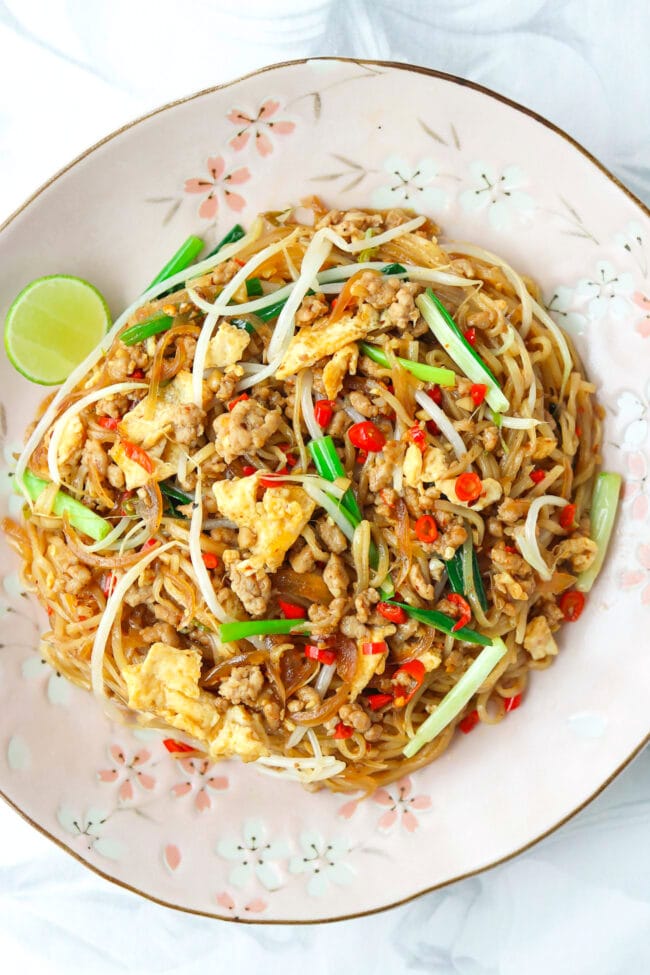
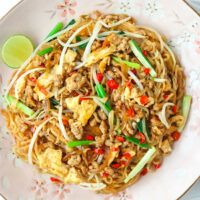





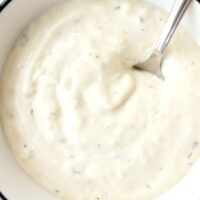

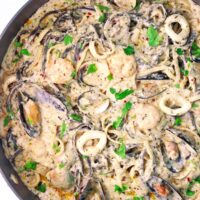
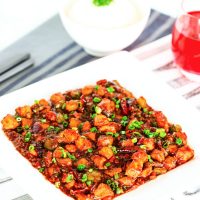
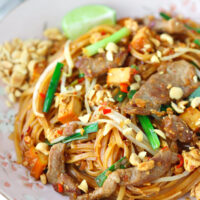
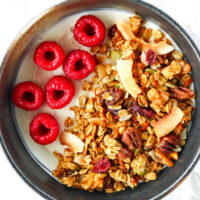

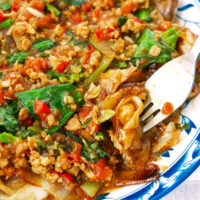

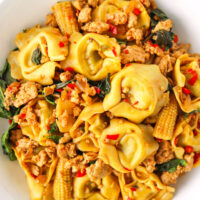
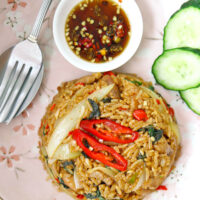
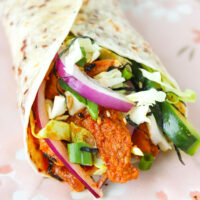
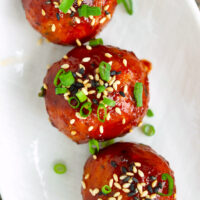

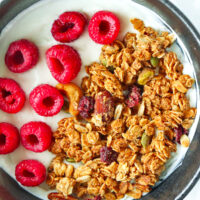
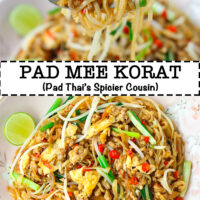
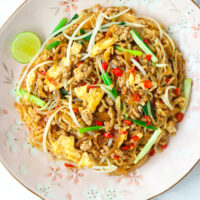
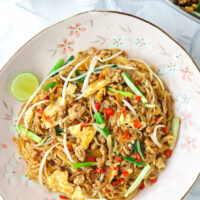
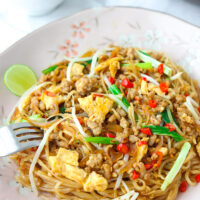
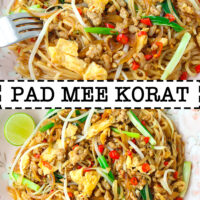
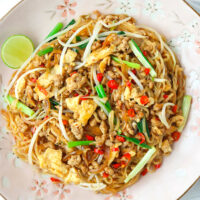
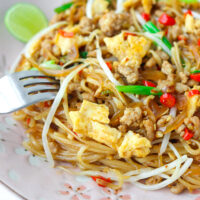
Loved the taste but used the recipe as a base and changed or omitted ingredients because of pantry availability.
The outcome was a great tasting dish which I will make more often, thank you
Hi Jim, I’m happy to hear it worked out well with the tweaks and tasted delicious! You’re most welcome and thank you for coming back to leave a rating and review. 🙂